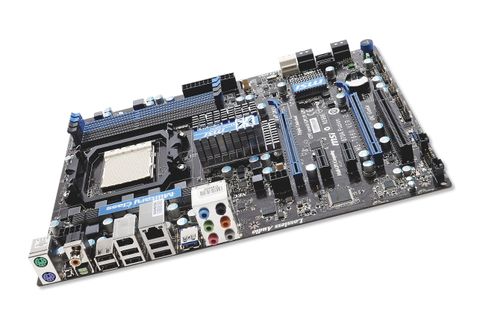Why you can trust TechRadar

The MSI 870A Fuzion is a well laid-out ATX board with plenty of space around the components.
The only real fly in the ointment is the positioning of a six-pin power connector, which enables additional power to be given to power hungry cards, but in any case it's doubtful if it will ever get used.
Although aimed at the mainstream market, the 870A Fuzion comes with some pretty high-end components in the power side of things. MSI calls it 'Military Class', so you get Hi-c (Highly Conductive Polymerised) capacitors, which last up to eight times longer than traditional solid capacitors, Icy Chokes that run cooler than traditional ones, and aluminium cored solid capacitors.
All of these offer better thermal stability and power efficiency than standard components, which is particularly important if you like to overclock your board.
To keep the price of the 870A Fuzion down, MSI has chosen to use the 870A/SB710 chipset combination.
The 870 is a pared down version of the 890, with support for just one X16 PCIe graphics slot, while the SB710 Southbridge only supports SATA 3Gbps. The 'A' name tag means it supports both SATA 6Gbps and USB 3.0, but it does so by using third-party controllers.
Obviously, if you're building a board with multi-GPU support you'll need more than one slot. MSI has engineered in another PCIe slot so both can run at full x16 speed, so if you don't go down the Hydra route, you can at least set up a Crossfire system. But not SLI.
At the heart of the board is the LT22102 version of Lucid's Hydra 200 chip.
Built on a 65nm process with a TDP of just six Watts, the Hydra 200 currently comes in three flavours; the LT22144 at the lowest end with 24 PCI lanes (single x8 connection to the CPU and two x8 to the GPU(s), the mainstream LT22012 with 48 lanes (single x16 connection to the CPU and two x16 connections to the GPU(s) and finally the high-end LT24102, again with 48 lanes but this time the two x16 lanes to the GPU's are configurable (4 x8, 1 x16 + 2 x8 or 2 x16).
The SB710 Southbridge provides support for six SATA 3Gbps ports, four of which are edge-mounted at ninety degrees while the remaining two are placed just inboard facing upwards for some reason. The two SATA 6Gbps ports (coloured white) are controlled by a Marvell 9128 controller, and these too are 90 degree edge-mounted.
Two USB 3.0 ports are provided, controlled by NEC's ubiquitous NEC D720200F1 chip. One of these ports is on the rear I/O panel, and the other is placed in-board just behind the audio output stack.
MSI reckons it's ready for the new generation of cases with USB 3.0 ports in the front panel, but it'll be a stretch to reach it where it is.
At least it's a nice thought.
Four DIMM slots are provided, supporting up to 16GB of 1066/1333MHz and 1600MHz (overclocked) DDR3 memory. So there isn't a great range of overclocking available on the memory, but then again, this is a board that's all about the graphics side of things and not hardcore overclocking.
MSI has used passive cooling for all the major components, with the Southbridge and some of the major power components sitting under their own heatsink, while the Northbridge and Lucid Hydra chip share one.
If you're used to seeing the massive passive coolers/heatpipe structures found on many boards, then their minimalist design will come as a surprise.
Current page: MSI 870A Fuzion - Technology and specifications
Prev Page MSI 870A Fuzion - Overview Next Page MSI 870A Fuzion - Benchmarks
